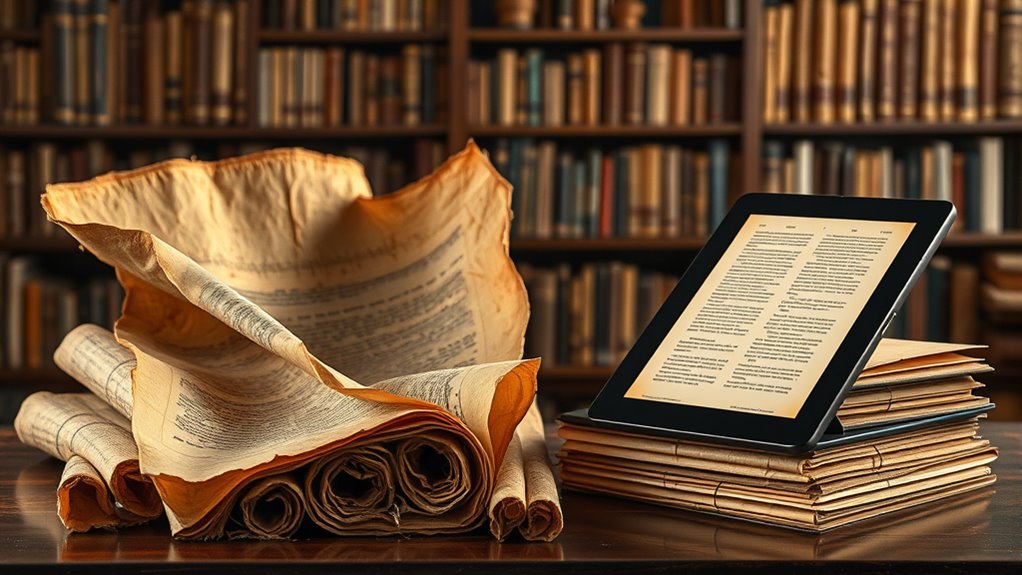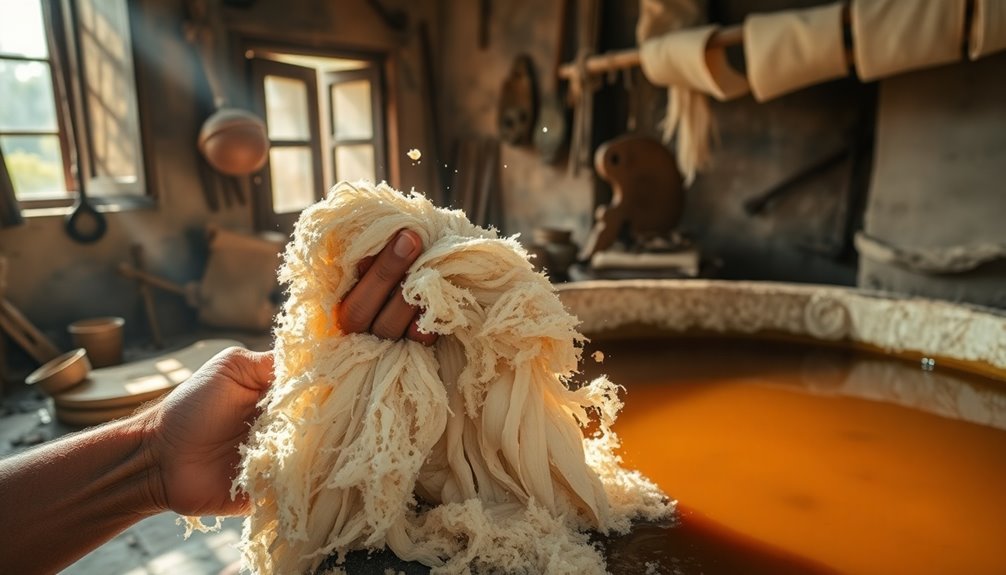The history of paper starts with ancient writing surfaces like stones, clay, and especially papyrus from Egypt, which revolutionized record-keeping. Over centuries, innovation led to the development of durable, affordable paper that fueled cultural, religious, and scientific progress. The Industrial Revolution improved production speed and quality, while today’s digital age reduces paper use further. If you keep exploring, you’ll discover how paper continues to evolve and adapt in our modern world.
Key Takeaways
- Early writing surfaces included stones, clay, bark, and papyrus, laying the foundation for paper development.
- Papyrus from Egypt revolutionized record-keeping and influenced subsequent cultures’ writing materials.
- The Industrial Revolution introduced mechanized, higher-quality paper, supporting mass communication and artistic expression.
- Modern advancements focus on eco-friendly recycling and sustainable materials to reduce environmental impact.
- The rise of digital media has decreased paper demand, transforming communication and preservation methods in contemporary society.
The Origins of Writing Surfaces in Ancient Civilizations
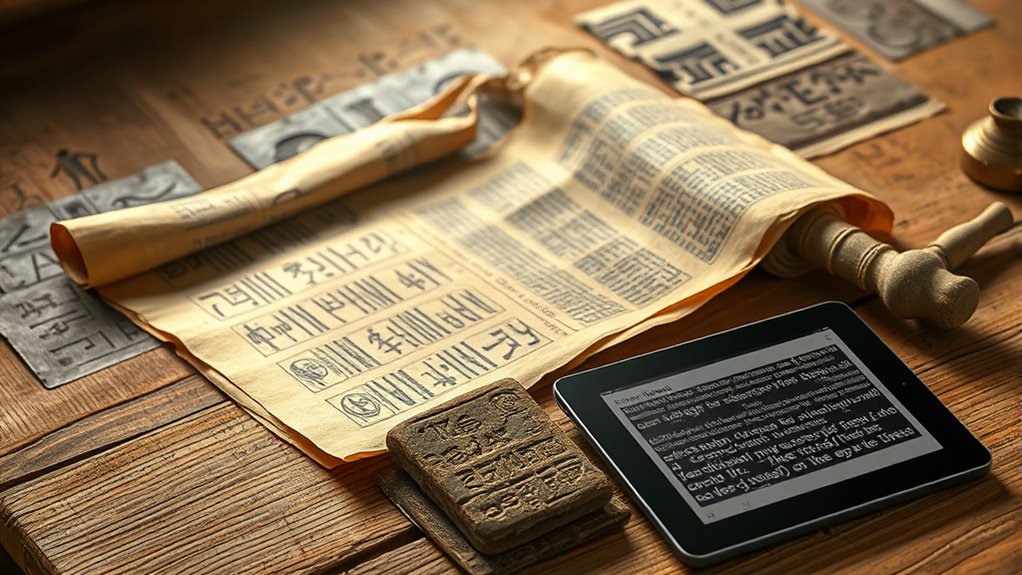
Ancient civilizations developed their earliest writing surfaces out of necessity, transforming natural materials into tools for communication. You might imagine early scribes using rough stones, clay tablets, or bark as their primary writing materials. To record messages, they created ancient ink from natural ingredients like charcoal, soot, or plant extracts, blending these with liquids to produce a durable, dark pigment. These materials allowed them to document laws, stories, and trade transactions, preserving their cultures for future generations. The choice of writing surfaces varied by region, but the need for a reliable medium led to innovations that laid the groundwork for later paper-making techniques. These early efforts highlight humanity’s drive to communicate and record knowledge using what was available in their environment.
The Development of Papyrus and Early Paper-Making Techniques
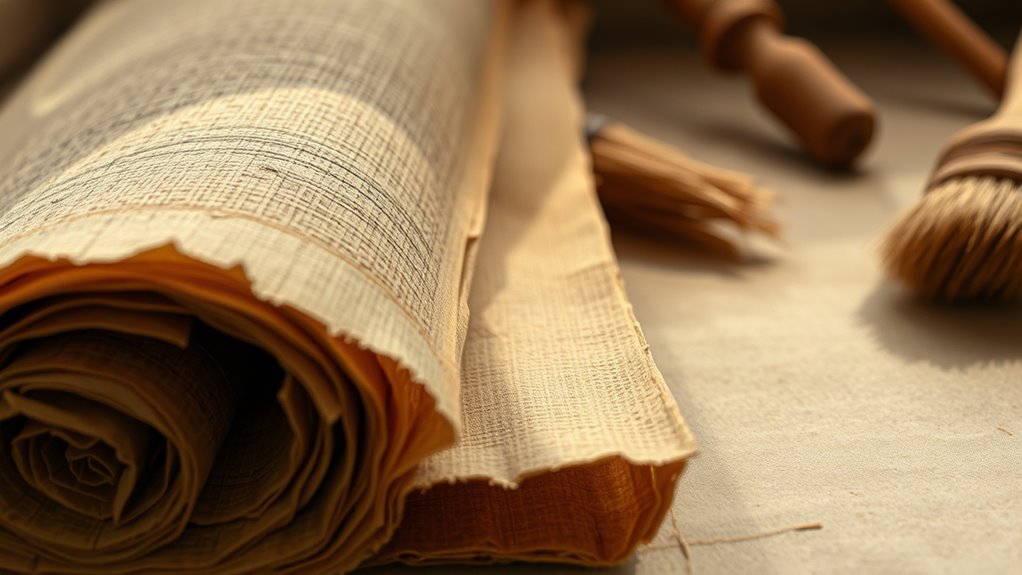
You’ll see how ancient Egyptians first created papyrus from reeds along the Nile, transforming plant material into a usable writing surface. Early paper-making techniques involved carefully processing and pressing these reeds to produce sheets suitable for writing. Understanding these origins helps you appreciate the innovations that shaped the development of paper throughout history.
Origins of Papyrus
The invention of papyrus revolutionized record-keeping and communication in early civilizations. You can see its significance in ancient writing, where papyrus served as the primary medium for recording stories, laws, and religious texts. Its development likely originated around the Nile Delta, where early Egyptians discovered that pressing strips of the papyrus plant’s stalks created a durable, flexible surface. The process involved slicing, layering, and pressing the fibers to form a sheet, a technique that laid the groundwork for future paper-making. Papyrus production also carried symbolic meaning, representing knowledge, authority, and communication in Egyptian society. Its widespread use demonstrated how a simple natural resource could transform cultural and administrative practices, making it an essential step toward the history of paper technologies that followed. Additionally, the methods of papyrus creation influenced subsequent writing materials across different cultures, showcasing its foundational role in the evolution of written communication.
Early Paper Manufacturing
Early paper manufacturing began with the innovative use of natural materials like papyrus, which early civilizations learned to transform into writable sheets. They developed techniques that improved paper preservation, allowing texts to last longer. Ancient ink was applied carefully to these surfaces, making writing more durable. As they refined their methods, they discovered how to create smoother, more uniform sheets, boosting readability and longevity. These early techniques spread across cultures, shaping how civilizations documented history and knowledge. The focus on paper preservation became essential, especially in dusty or humid environments, to prevent deterioration. Over time, these innovations laid the groundwork for more advanced paper-making processes, setting the stage for the evolution of paper into a crucial medium for communication and record-keeping.
The Role of Paper in Medieval and Renaissance Societies

Have you ever wondered how paper transformed the way people communicated and recorded knowledge during medieval and Renaissance times? During this period, paper became essential for creating medieval manuscripts, which preserved religious texts, literature, and scientific ideas. It also played a key role in renaissance art, enabling artists to sketch, plan, and develop detailed works. With more affordable and accessible paper, literacy spread, and ideas circulated faster. You can imagine scholars and artists working on parchment-like materials, sharing knowledge across borders. This shift made knowledge more durable and portable, fueling cultural growth.
Paper revolutionized communication, preserving knowledge and fueling cultural growth during medieval and Renaissance times.
- The proliferation of medieval manuscripts made knowledge more accessible.
- Renaissance artists used paper for sketches and detailed illustrations.
- Paper helped spread new ideas, fostering innovation and learning.
Innovations in Paper Production During the Industrial Revolution
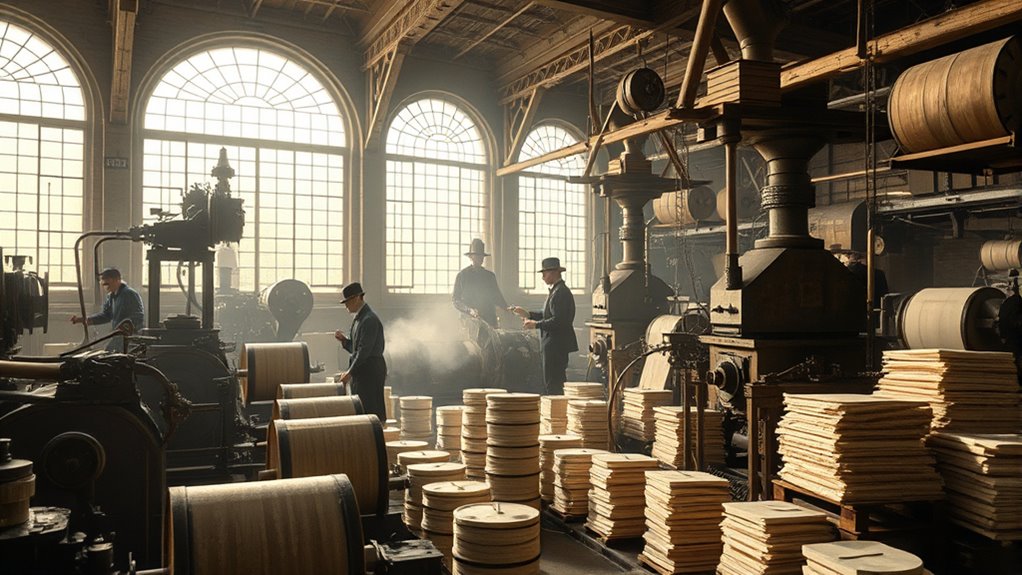
During the Industrial Revolution, you’ll see how mechanization transformed paper production, making it faster and more efficient. These innovations led to stronger, higher-quality paper that could meet increased demand. As a result, paper became more accessible and versatile than ever before. Additionally, advancements in industrial AI applications contributed to optimizing manufacturing processes and quality control in paper production. Implementing automation in manufacturing further enhanced production speed and consistency, setting the stage for modern paper industry standards. The integration of advanced machinery and processes also played a crucial role in scaling up production capabilities and improving product uniformity, alongside innovations in quality assurance techniques.
Mechanization of Manufacturing
How did the Industrial Revolution transform paper manufacturing? It revolutionized the industry through mechanization, enabling mass production and faster output. You experienced significant automation advances, replacing manual labor with machines that increased efficiency and consistency. These innovations allowed paper to be produced on a much larger scale, lowering costs and making it more accessible. Additionally, the adoption of affiliate disclosures ensured transparency in commercial relationships within the industry.
- Introduction of steam-powered paper mills for continuous production
- Development of automated paper machines that streamlined processes
- Standardization of paper sizes to meet growing demand
With these changes, you’d notice a shift from handcrafted sheets to uniform rolls, fueling the expansion of print media and education. The mechanization of manufacturing laid the foundation for modern paper industries, shaping how you consume information today.
Improved Paper Qualities
Advancements in paper production during the Industrial Revolution led to significant improvements in paper quality, making it stronger, smoother, and more durable. These innovations allowed for better printing and increased lifespan, supporting wider distribution. You can now find sustainable alternatives that reduce environmental impact, such as recycled fibers and plant-based materials. The era also saw the rise of decorative techniques, enabling artists and publishers to enhance the aesthetic appeal of their work. These techniques included embossed textures, watermarks, and colored inks, which added value and uniqueness to paper products. Additionally, the development of Gold IRA Rollovers contributed to the diversification of investment assets, reflecting a broader trend of innovation and adaptation in various industries. As a result, paper became more versatile, appealing, and environmentally conscious, meeting the demands of a growing market and paving the way for modern innovations.
The Transition to Digital Media and Its Impact on Paper Usage
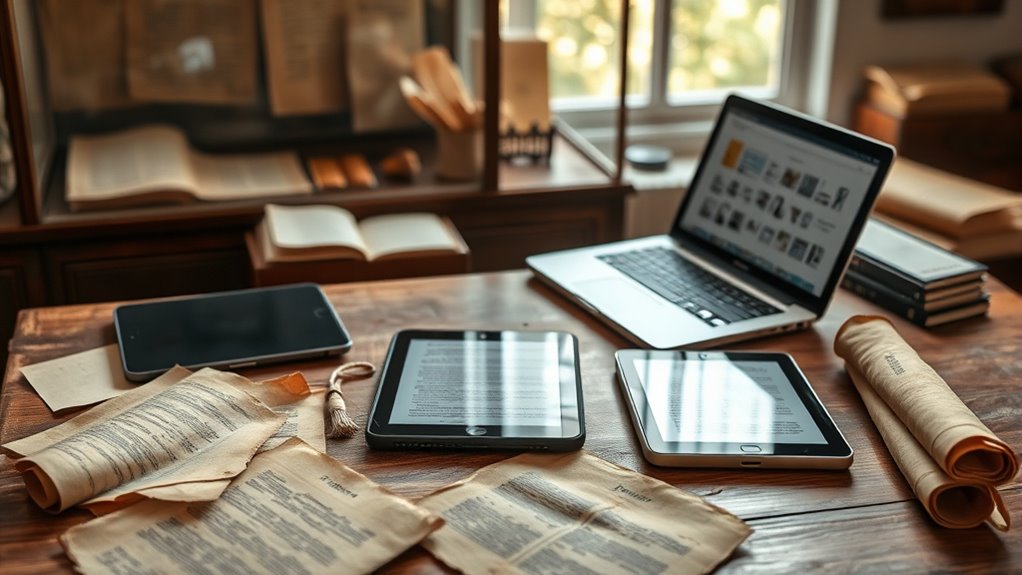
As digital media becomes increasingly prevalent, its rise has markedly reduced the demand for paper across many industries. This digital transformation has reshaped how we communicate, store, and share information, leading to a decline in paper use. You might notice fewer printed reports, catalogs, and newspapers in your daily life. The environmental impact of this shift is significant, as it helps conserve forests and reduces waste. Plus, digital options often offer faster, more efficient access to information. Additionally, the adoption of cold-pressed vegetable juice and eco-friendly practices in manufacturing industries further supports sustainability efforts. This transition is also supported by the adoption of sustainable materials and eco-friendly practices in manufacturing industries. For instance, the use of eco-friendly manufacturing techniques can further lessen the environmental footprint of paper alternatives. Moreover, innovations in recycling technology improve the efficiency of repurposing paper products, enhancing sustainability. However, it also means that industries need to adapt and innovate to stay relevant. Here are some key points:
- Reduced deforestation and pollution
- Increased reliance on electronic devices
- Shifts in manufacturing and supply chains
- The adoption of affiliate disclosure policies by many online platforms further influences how companies communicate with consumers, emphasizing transparency and trust.
Preserving the Future of Paper in a Digital World
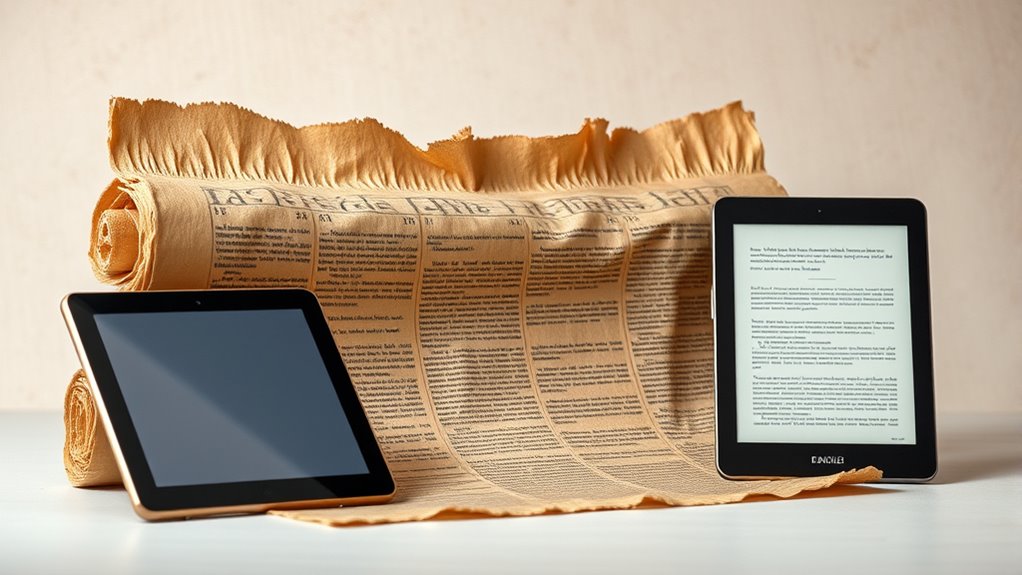
Despite the rise of digital media, efforts to preserve the future of paper remain essential for maintaining cultural heritage, supporting sustainable practices, and fostering innovation. You can help by choosing recycled paper products and supporting companies that prioritize eco-friendly materials. Recycling innovations play a crucial role in reducing the environmental impact of paper production, conserving resources, and minimizing waste. Advanced recycling techniques allow for higher-quality paper to be made from used materials, closing the loop and decreasing reliance on virgin fibers. Educating others about sustainable practices ensures that paper’s cultural significance continues without harming the planet. By balancing tradition with innovation, you contribute to a future where paper remains a fundamental part of human expression and environmental stewardship.
Frequently Asked Questions
How Did Different Ancient Civilizations Influence Paper Development Worldwide?
You see, different ancient civilizations shaped paper development through their innovations. The Egyptians used papyrus, boosting the papyrus trade and inspiring similar materials elsewhere. Meanwhile, the Chinese experimented with ancient ink and paper techniques, refining their methods and spreading them via trade routes. These influences blend together, creating a rich history that laid the foundation for the diverse paper types we use today.
What Were the Environmental Impacts of Early Paper-Making Techniques?
Environmental impacts emerge easily when you explore early paper-making. You’ll see environmental degradation and resource depletion due to the extensive harvesting of raw materials like fibers and trees. Early techniques often lacked sustainability, leading to deforestation and habitat harm. As you examine these practices, remember how resourceful but risky their methods were, emphasizing the importance of modern, eco-friendly innovations in paper production today.
How Did Paper Influence Literacy and Education During Medieval Times?
During medieval times, paper markedly boosted literacy and expanded education access. You’d find that affordable paper made books more available, enabling more people to learn and share knowledge. This democratization of information helped spread ideas and fostered learning beyond the elite. As a result, paper became essential for medieval literacy, empowering communities and supporting the growth of educational institutions, shaping society’s intellectual development during that era.
What Innovations in Paper Recycling Emerged During the Industrial Era?
Imagine turning waste into wealth—during the industrial era, recycling innovations revolutionized paper production. You see, industrial processing advanced with techniques like de-inking and fiber recovery, transforming old paper into new sheets. These innovations not only reduced reliance on raw materials but also sped up production. By embracing these methods, industries could mass-produce affordable paper, fueling literacy and knowledge spread, proving that innovation can truly turn trash into treasure.
Will Digital Media Eventually Replace All Traditional Paper Uses Completely?
You might wonder if digital dominance will lead to paper extinction someday. While digital media continues to grow, it’s unlikely it’ll replace all traditional paper uses completely. Many industries still rely on paper for legal, artistic, and practical reasons. So, even as technology advances, you’ll probably see a continued coexistence, with paper playing a role alongside digital media rather than vanishing entirely.
Conclusion
As you consider the journey from ancient papyrus to today’s digital screens, one thing becomes clear: paper’s story isn’t over yet. Will it adapt and survive in a world dominated by technology, or fade into history? The future holds secrets we’ve yet to uncover—innovations that could redefine how we create, share, and preserve knowledge. Stay curious, because what’s next might just surprise us all, changing the way we see the world forever.

